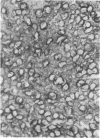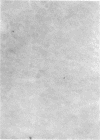Abstract
We have investigated human gliomas that amplify and rearrange the epidermal growth factor receptor gene, with generation of an in-frame deletion mutation of 802 nucleotides in the external domain. This in-frame deletion mutation generates a local amino acid sequence at the fusion junction of what normally were distant polypeptide sequences in the intact epidermal growth factor receptor. This 14-amino acid peptide was chemically synthesized, coupled to keyhole limpet hemocyanin, and used as an immunogen in rabbits. The elicited antibody reacted specifically with the fusion peptide in ELISA. The anti-fusion junction peptide antibody was purified by passage of the antiserum over a peptide affinity column with acidic elution. The purified antibody selectively bound the glioma deletion mutant as compared to the intact epidermal growth factor receptor as assessed by immunocytochemistry, immunofluorescence, immunoprecipitation with gel electrophoresis, and binding experiments using radioiodinated antibody. These data indicate that it is feasible to generate site-specific anti-peptide antibodies that are highly selective for mutant proteins in human tumors. The anti-peptide antibody described here, and other mutation site-specific antibodies, should be ideal candidates for tumor immunoimaging and immunotherapy.
Full text
PDF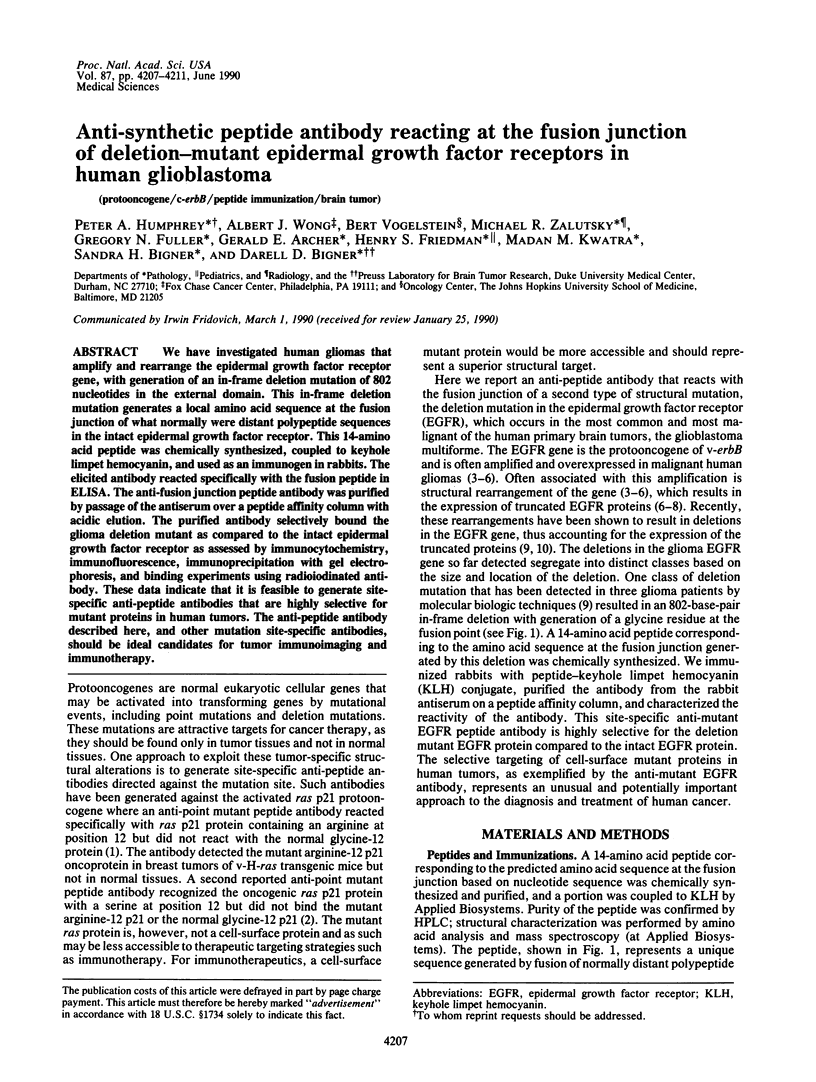
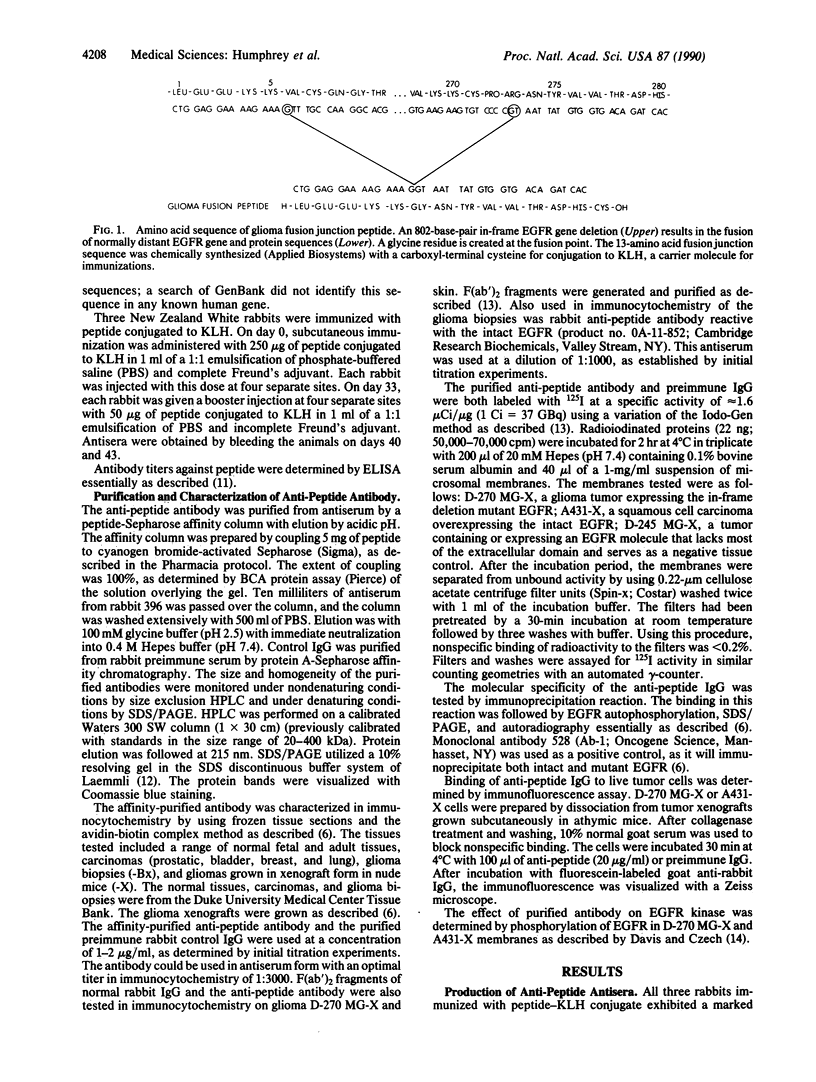
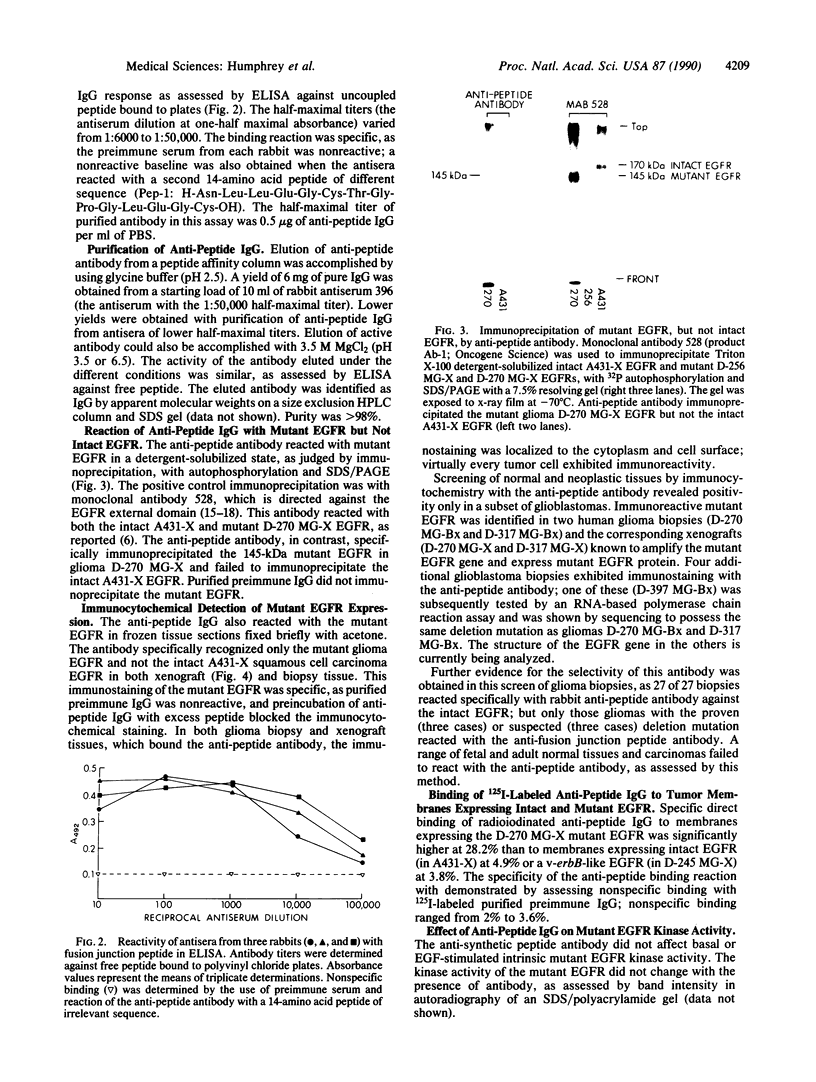
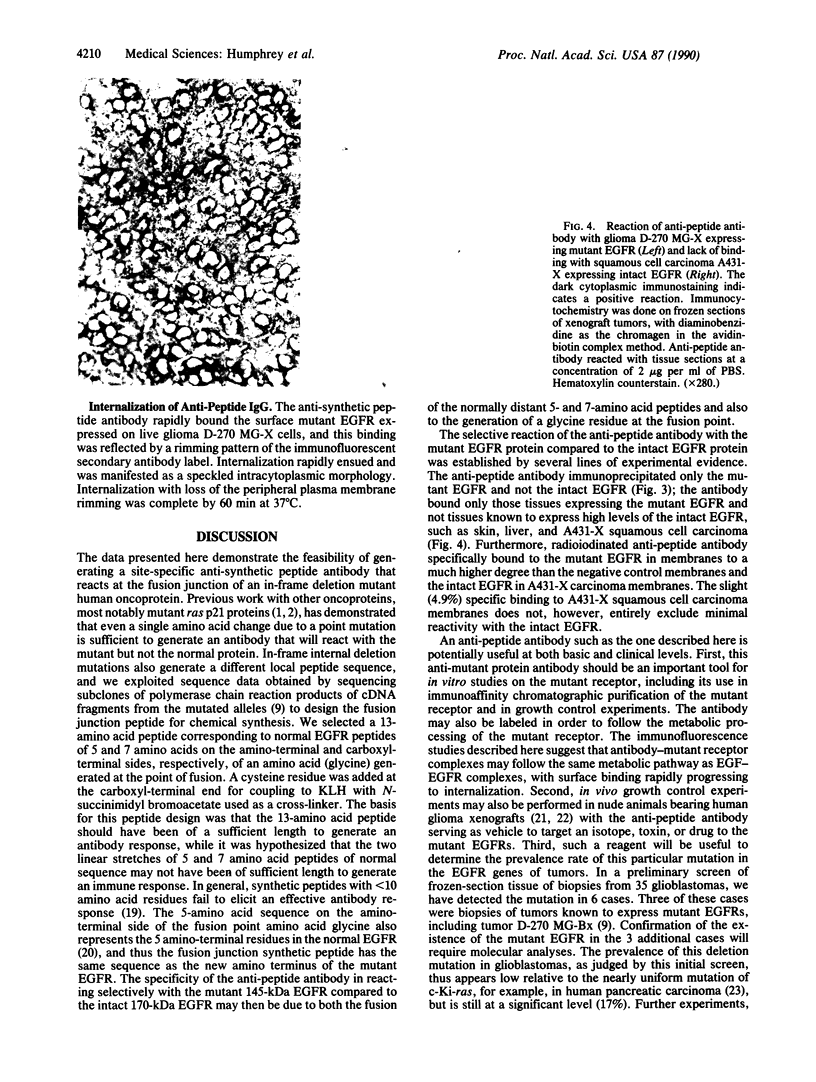
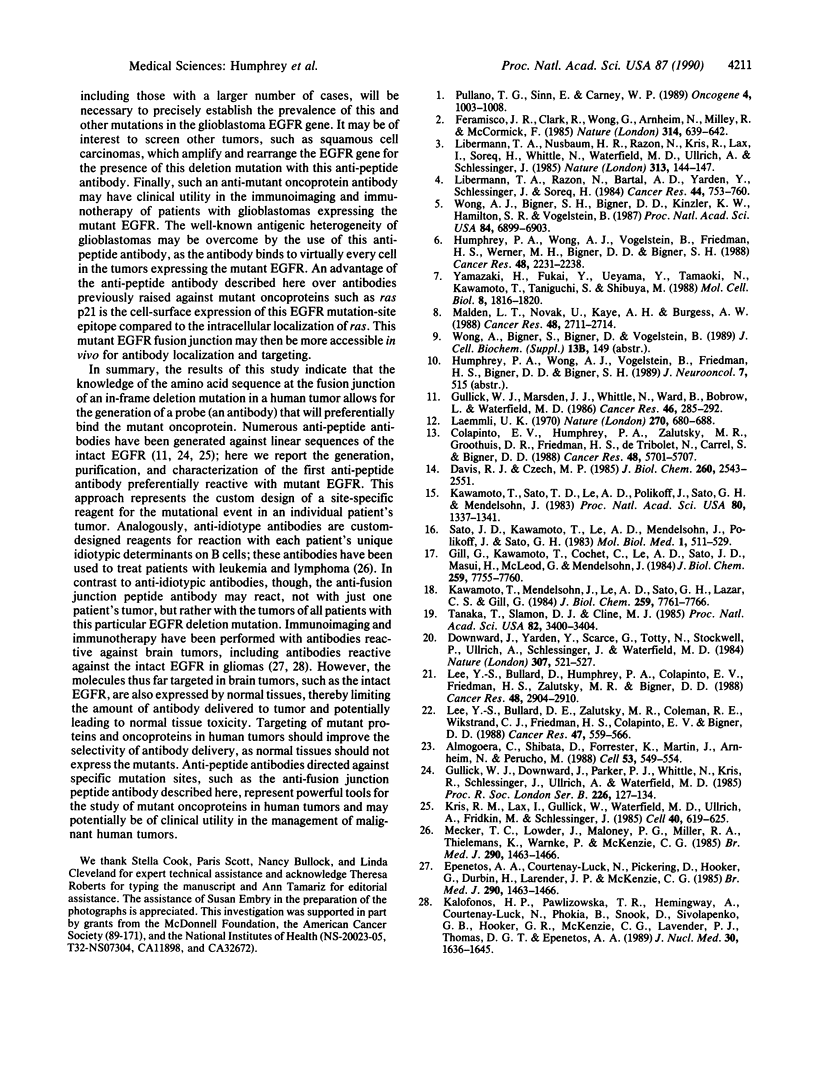
Images in this article
Selected References
These references are in PubMed. This may not be the complete list of references from this article.
- Almoguera C., Shibata D., Forrester K., Martin J., Arnheim N., Perucho M. Most human carcinomas of the exocrine pancreas contain mutant c-K-ras genes. Cell. 1988 May 20;53(4):549–554. doi: 10.1016/0092-8674(88)90571-5. [DOI] [PubMed] [Google Scholar]
- Colapinto E. V., Humphrey P. A., Zalutsky M. R., Groothuis D. R., Friedman H. S., de Tribolet N., Carrel S., Bigner D. D. Comparative localization of murine monoclonal antibody Me1-14 F(ab')2 fragment and whole IgG2a in human glioma xenografts. Cancer Res. 1988 Oct 15;48(20):5701–5707. [PubMed] [Google Scholar]
- Davis R. J., Czech M. P. Amiloride directly inhibits growth factor receptor tyrosine kinase activity. J Biol Chem. 1985 Feb 25;260(4):2543–2551. [PubMed] [Google Scholar]
- Downward J., Yarden Y., Mayes E., Scrace G., Totty N., Stockwell P., Ullrich A., Schlessinger J., Waterfield M. D. Close similarity of epidermal growth factor receptor and v-erb-B oncogene protein sequences. Nature. 1984 Feb 9;307(5951):521–527. doi: 10.1038/307521a0. [DOI] [PubMed] [Google Scholar]
- Epenetos A. A., Courtenay-Luck N., Pickering D., Hooker G., Durbin H., Lavender J. P., McKenzie C. G. Antibody guided irradiation of brain glioma by arterial infusion of radioactive monoclonal antibody against epidermal growth factor receptor and blood group A antigen. Br Med J (Clin Res Ed) 1985 May 18;290(6480):1463–1466. doi: 10.1136/bmj.290.6480.1463. [DOI] [PMC free article] [PubMed] [Google Scholar]
- Feramisco J. R., Clark R., Wong G., Arnheim N., Milley R., McCormick F. Transient reversion of ras oncogene-induced cell transformation by antibodies specific for amino acid 12 of ras protein. Nature. 1985 Apr 18;314(6012):639–642. doi: 10.1038/314639a0. [DOI] [PubMed] [Google Scholar]
- Gill G. N., Kawamoto T., Cochet C., Le A., Sato J. D., Masui H., McLeod C., Mendelsohn J. Monoclonal anti-epidermal growth factor receptor antibodies which are inhibitors of epidermal growth factor binding and antagonists of epidermal growth factor binding and antagonists of epidermal growth factor-stimulated tyrosine protein kinase activity. J Biol Chem. 1984 Jun 25;259(12):7755–7760. [PubMed] [Google Scholar]
- Gullick W. J., Downward J., Parker P. J., Whittle N., Kris R., Schlessinger J., Ullrich A., Waterfield M. D. The structure and function of the epidermal growth factor receptor studied by using antisynthetic peptide antibodies. Proc R Soc Lond B Biol Sci. 1985 Oct 22;226(1242):127–134. doi: 10.1098/rspb.1985.0087. [DOI] [PubMed] [Google Scholar]
- Gullick W. J., Marsden J. J., Whittle N., Ward B., Bobrow L., Waterfield M. D. Expression of epidermal growth factor receptors on human cervical, ovarian, and vulval carcinomas. Cancer Res. 1986 Jan;46(1):285–292. [PubMed] [Google Scholar]
- Humphrey P. A., Wong A. J., Vogelstein B., Friedman H. S., Werner M. H., Bigner D. D., Bigner S. H. Amplification and expression of the epidermal growth factor receptor gene in human glioma xenografts. Cancer Res. 1988 Apr 15;48(8):2231–2238. [PubMed] [Google Scholar]
- Kalofonos H. P., Pawlikowska T. R., Hemingway A., Courtenay-Luck N., Dhokia B., Snook D., Sivolapenko G. B., Hooker G. R., McKenzie C. G., Lavender P. J. Antibody guided diagnosis and therapy of brain gliomas using radiolabeled monoclonal antibodies against epidermal growth factor receptor and placental alkaline phosphatase. J Nucl Med. 1989 Oct;30(10):1636–1645. [PubMed] [Google Scholar]
- Kawamoto T., Mendelsohn J., Le A., Sato G. H., Lazar C. S., Gill G. N. Relation of epidermal growth factor receptor concentration to growth of human epidermoid carcinoma A431 cells. J Biol Chem. 1984 Jun 25;259(12):7761–7766. [PubMed] [Google Scholar]
- Kawamoto T., Sato J. D., Le A., Polikoff J., Sato G. H., Mendelsohn J. Growth stimulation of A431 cells by epidermal growth factor: identification of high-affinity receptors for epidermal growth factor by an anti-receptor monoclonal antibody. Proc Natl Acad Sci U S A. 1983 Mar;80(5):1337–1341. doi: 10.1073/pnas.80.5.1337. [DOI] [PMC free article] [PubMed] [Google Scholar]
- Kris R. M., Lax I., Gullick W., Waterfield M. D., Ullrich A., Fridkin M., Schlessinger J. Antibodies against a synthetic peptide as a probe for the kinase activity of the avian EGF receptor and v-erbB protein. Cell. 1985 Mar;40(3):619–625. doi: 10.1016/0092-8674(85)90210-7. [DOI] [PubMed] [Google Scholar]
- Laemmli U. K. Cleavage of structural proteins during the assembly of the head of bacteriophage T4. Nature. 1970 Aug 15;227(5259):680–685. doi: 10.1038/227680a0. [DOI] [PubMed] [Google Scholar]
- Lee Y. S., Bullard D. E., Zalutsky M. R., Coleman R. E., Wikstrand C. J., Friedman H. S., Colapinto E. V., Bigner D. D. Therapeutic efficacy of antiglioma mesenchymal extracellular matrix 131I-radiolabeled murine monoclonal antibody in a human glioma xenograft model. Cancer Res. 1988 Feb 1;48(3):559–566. [PubMed] [Google Scholar]
- Lee Y., Bullard D. E., Humphrey P. A., Colapinto E. V., Friedman H. S., Zalutsky M. R., Coleman R. E., Bigner D. D. Treatment of intracranial human glioma xenografts with 131I-labeled anti-tenascin monoclonal antibody 81C6. Cancer Res. 1988 May 15;48(10):2904–2910. [PubMed] [Google Scholar]
- Libermann T. A., Nusbaum H. R., Razon N., Kris R., Lax I., Soreq H., Whittle N., Waterfield M. D., Ullrich A., Schlessinger J. Amplification, enhanced expression and possible rearrangement of EGF receptor gene in primary human brain tumours of glial origin. Nature. 1985 Jan 10;313(5998):144–147. doi: 10.1038/313144a0. [DOI] [PubMed] [Google Scholar]
- Libermann T. A., Razon N., Bartal A. D., Yarden Y., Schlessinger J., Soreq H. Expression of epidermal growth factor receptors in human brain tumors. Cancer Res. 1984 Feb;44(2):753–760. [PubMed] [Google Scholar]
- Malden L. T., Novak U., Kaye A. H., Burgess A. W. Selective amplification of the cytoplasmic domain of the epidermal growth factor receptor gene in glioblastoma multiforme. Cancer Res. 1988 May 15;48(10):2711–2714. [PubMed] [Google Scholar]
- Pullano T. G., Sinn E., Carney W. P. Characterization of monoclonal antibody R256, specific for activated ras p21 with arginine at 12, and analysis of breast carcinoma of v-Harvey-ras transgenic mouse. Oncogene. 1989 Aug;4(8):1003–1008. [PubMed] [Google Scholar]
- Sato J. D., Kawamoto T., Le A. D., Mendelsohn J., Polikoff J., Sato G. H. Biological effects in vitro of monoclonal antibodies to human epidermal growth factor receptors. Mol Biol Med. 1983 Dec;1(5):511–529. [PubMed] [Google Scholar]
- Tanaka T., Slamon D. J., Cline M. J. Efficient generation of antibodies to oncoproteins by using synthetic peptide antigens. Proc Natl Acad Sci U S A. 1985 May;82(10):3400–3404. doi: 10.1073/pnas.82.10.3400. [DOI] [PMC free article] [PubMed] [Google Scholar]
- Wong A. J., Bigner S. H., Bigner D. D., Kinzler K. W., Hamilton S. R., Vogelstein B. Increased expression of the epidermal growth factor receptor gene in malignant gliomas is invariably associated with gene amplification. Proc Natl Acad Sci U S A. 1987 Oct;84(19):6899–6903. doi: 10.1073/pnas.84.19.6899. [DOI] [PMC free article] [PubMed] [Google Scholar]
- Yamazaki H., Fukui Y., Ueyama Y., Tamaoki N., Kawamoto T., Taniguchi S., Shibuya M. Amplification of the structurally and functionally altered epidermal growth factor receptor gene (c-erbB) in human brain tumors. Mol Cell Biol. 1988 Apr;8(4):1816–1820. doi: 10.1128/mcb.8.4.1816. [DOI] [PMC free article] [PubMed] [Google Scholar]




